traction control CITROEN BERLINGO ELECTRIC 2015 Handbook (in English)
[x] Cancel search | Manufacturer: CITROEN, Model Year: 2015, Model line: BERLINGO ELECTRIC, Model: CITROEN BERLINGO ELECTRIC 2015Pages: 272, PDF Size: 8.92 MB
Page 34 of 272
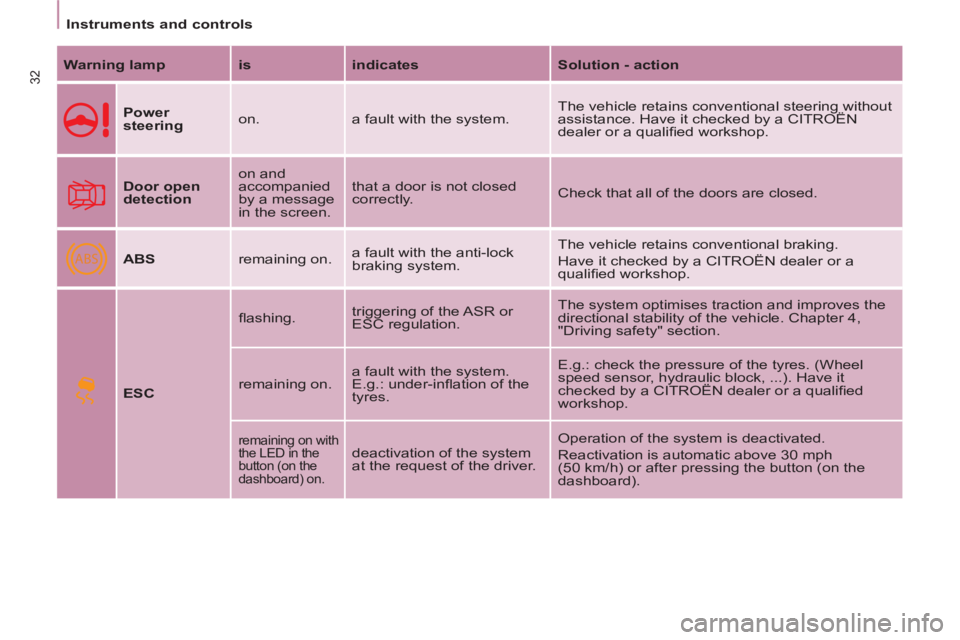
ABS
32
Instruments and controls
Warning lamp
is
indicates
Solution - action
Power
steering
on. a fault with the system. The vehicle retains conventional steering without
assistance. Have it checked by a CITROËN
dealer or a qualifi ed workshop.
Door open
detection
on and
accompanied
by a message
in the screen. that a door is not closed
correctly. Check that all of the doors are closed.
ABS
remaining on. a fault with the anti-lock
braking system. The vehicle retains conventional braking.
Have it checked by a CITROËN dealer or a
qualifi ed workshop.
ESC
fl ashing. triggering of the ASR or
ESC regulation. The system optimises traction and improves the
directional stability of the vehicle. Chapter 4,
"Driving safety" section.
remaining on. a fault with the system.
E.g.: under-infl ation of the
tyres. E.g.: check the pressure of the tyres. (Wheel
speed sensor, hydraulic block, ...). Have it
checked by a CITROËN dealer or a qualifi ed
workshop.
remaining on with
the LED in the
button (on the
dashboard) on. deactivation of the system
at the request of the driver. Operation of the system is deactivated.
Reactivation is automatic above 30 mph
(50 km/h) or after pressing the button (on the
dashboard).
Page 88 of 272

86
Driving safely
"GRIP CONTROL"
The accelerator pedal must be pressed
enough for there to be adequate
engine power to manage the various
parameters in the best way. On snow, mud and sand, traction
control is obtained by a compromise
between safety, grip and traction,
which is associated with the Michelin
®
Latitude Tour HP M+S tyres.
It adapts to allows most conditions of
poor grip to be accommodated.
Correct use
Your vehicle is designed principally to
drive on tarmac roads but it allows you
to drive on other less passable terrain
occasionally.
However, particularly when your
vehicle is heavily laden, it does not
permit off-road activities such as:
- crossing and driving on ground
which could damage the underbody
or tear off components (fuel pipe,
fuel cooler, ...), particularly by
obstacles or stones,
- driving on ground with steep
gradients and poor grip,
- crossing a stream.
Page 240 of 272
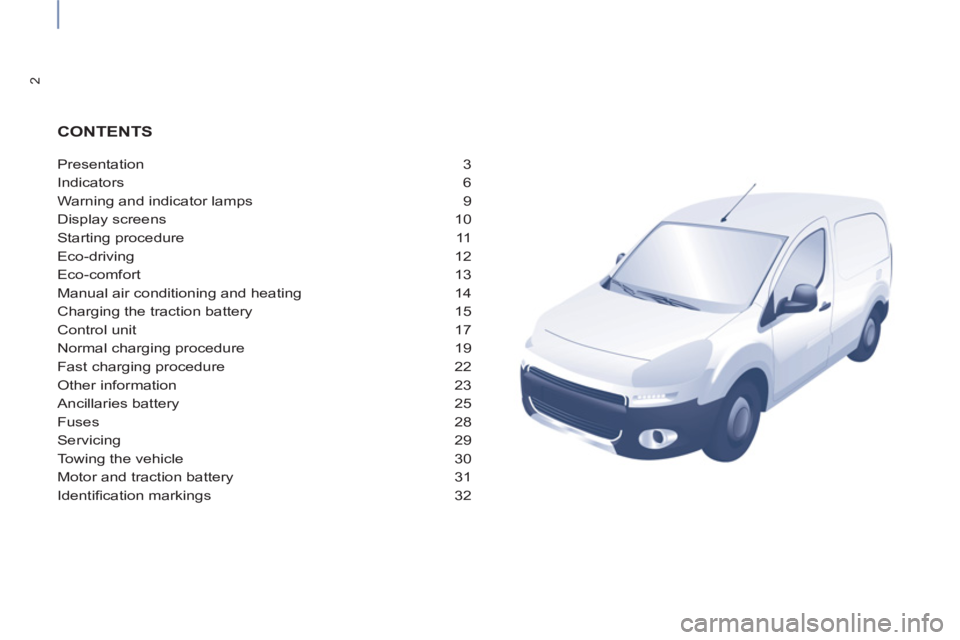
2
Presentation3
Indicators6
Warning and indicator lamps9
Display screens 10
Starting procedure 11
Eco-driving 12
Eco-comfort 13
Manual air conditioning and heating 14
Charging the traction battery 15
Control unit 17
Normal charging procedure 19
Fast charging procedure 22
Other information 23
Ancillaries battery 25
Fuses 28
Servicing 29
Towing the vehicle 30
Motor and traction battery 31
Identifi cation markings 32
CONTENTS
Page 243 of 272

5
INSTRUMENTS AND CONTROLS
Instrument panel
Current energy consumption and
generation indicator
p.6 Traction battery state of charge
indicator
p.7
Dedicated warning and indicator lamps
p.9 Drive selector position
p.11 Estimated remaining range
p.10 Heating and air conditioning
systems energy consumption
indicator
p.8, 13 and 14
"Ready"
lamp
p.9
Page 245 of 272
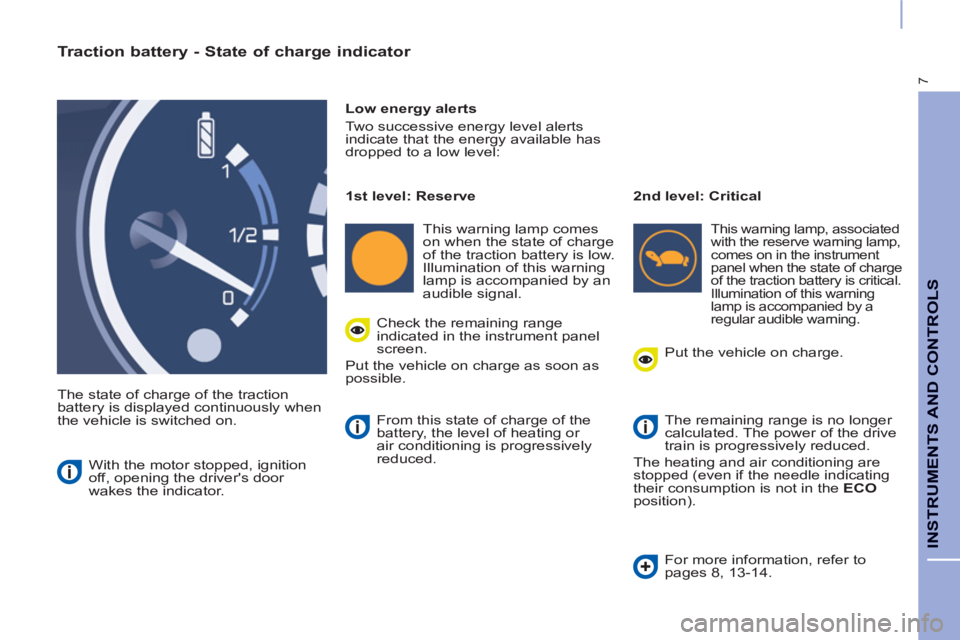
7
INSTRUMENTS AND CONTROLS
Traction battery - State of charge indicator
The state of charge of the traction
battery is displayed continuously when
the vehicle is switched on.
Low energy alerts
Two successive energy level alerts
indicate that the energy available has
dropped to a low level:
With the motor stopped, ignition
off, opening the driver's door
wakes the indicator.
1st level: Reserve
This warning lamp comes
on when the state of charge
of the traction battery is low.
Illumination of this warning
lamp is accompanied by an
audible signal.
2nd level: Critical
This warning lamp, associated
with the reserve warning lamp,
comes on in the instrument
panel when the state of charge
of the traction battery is critical.
Illumination of this warning
lamp is accompanied by a
regular audible warning.
Check the remaining range
indicated in the instrument panel
screen.
Put the vehicle on charge as soon as
possible. Put the vehicle on charge.
The remaining range is no longer
calculated. The power of the drive
train is progressively reduced.
The heating and air conditioning are
stopped (even if the needle indicating
their consumption is not in the ECO
position). From this state of charge of the
battery, the level of heating or
air conditioning is progressively
reduced.
For more information, refer to
pages 8, 13-14.
Page 247 of 272
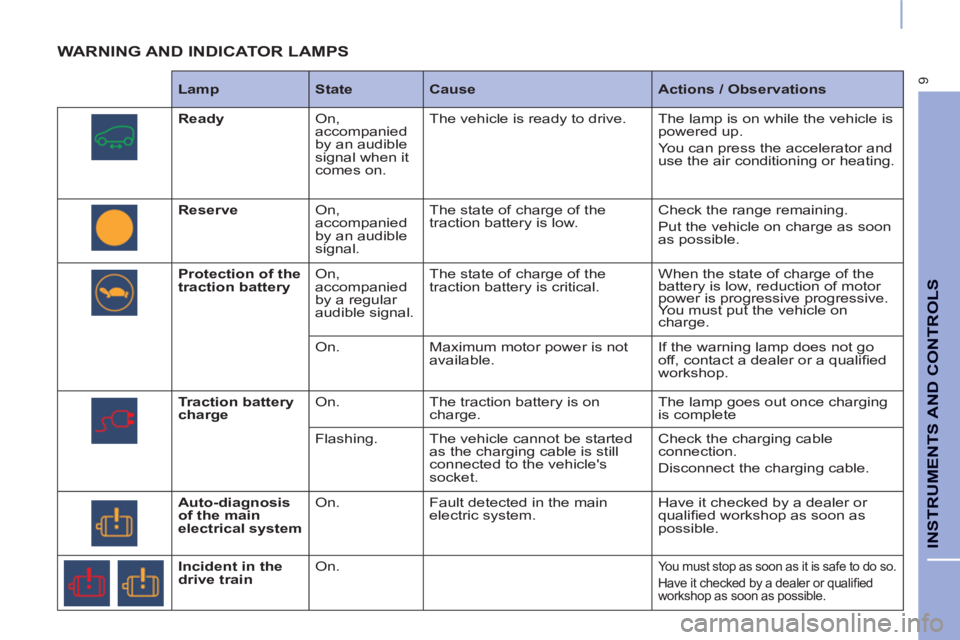
9
INSTRUMENTS AND CONTROLS
WARNING AND INDICATOR LAMPS
Lamp
State
Cause
Actions / Observations
Ready
On,
accompanied
by an audible
signal when it
comes on. The vehicle is ready to drive. The lamp is on while the vehicle is
powered up.
You can press the accelerator and
use the air conditioning or heating.
Reserve
On,
accompanied
by an audible
signal. The state of charge of the
traction battery is low. Check the range remaining.
Put the vehicle on charge as soon
as possible.
Protection of the
traction battery
On,
accompanied
by a regular
audible signal. The state of charge of the
traction battery is critical. When the state of charge of the
battery is low, reduction of motor
power is progressive progressive.
You must put the vehicle on
charge.
On. Maximum motor power is not
available. If the warning lamp does not go
off, contact a dealer or a qualifi ed
workshop.
Traction
battery
charge
On. The traction battery is on
charge. The lamp goes out once charging
is complete
Flashing. The vehicle cannot be started
as the charging cable is still
connected to the vehicle's
socket. Check the charging cable
connection.
Disconnect the charging cable.
Auto-diagnosis
of the main
electrical system
On. Fault detected in the main
electric system. Have it checked by a dealer or
qualifi ed workshop as soon as
possible.
Incident in the
drive train
On.
You must stop as soon as it is safe to do so.
Have it checked by a dealer or qualifi ed
workshop as soon as possible.
Page 251 of 272
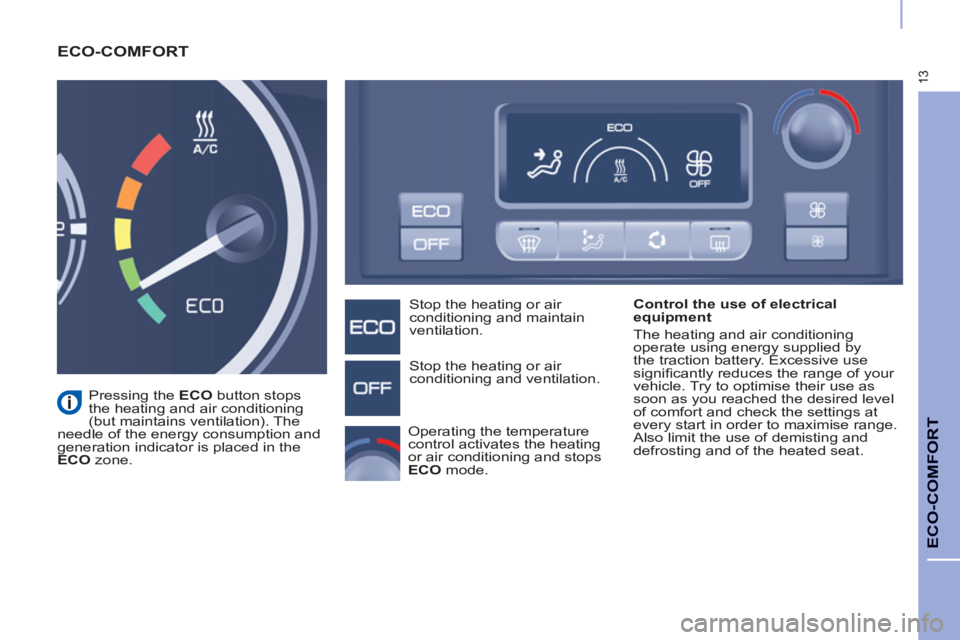
13
ECO-COMFORT
ECO-COMFORT
Control the use of electrical
equipment
The heating and air conditioning
operate using energy supplied by
the traction battery. Excessive use
signifi cantly reduces the range of your
vehicle. Try to optimise their use as
soon as you reached the desired level
of comfort and check the settings at
every start in order to maximise range.
Also limit the use of demisting and
defrosting and of the heated seat.
Stop the heating or air
conditioning and maintain
ventilation.
Stop the heating or air
conditioning and ventilation.
Pressing the ECO
button stops
the heating and air conditioning
(but maintains ventilation). The
needle of the energy consumption and
generation indicator is placed in the
ECO
zone.
Operating the temperature
control activates the heating
or air conditioning and stops
ECO
mode.
Page 255 of 272

17
CHARGING THE TRACTION BATTERY
Do not touch the metal end of
the normal charging socket, nor
of the charging cable. Risk of
electrocution and/or malfunctions.
Use the cord supplied to hook the
control unit, so that it does not
weigh down on the power point
(risk of damage to the charging cable
or power point).
Never connect or disconnect the
the cable or charging plug with
wet hands
(risk of electrocution).
The charge may be interrupted
at any time by withdrawing the
charging plug.
If exceptionally you have
to interrupt the charge by
disconnecting the charging cable
from the power point, it is essential to
fi rst press the Manual Stop
button on
the controller.
It has four indicator lamps:
- STOP
: on red.
It indicates that charging has
been interrupted by pressing
the Manual Stop
button. This
action is recommended before
disconnecting the charging cable
from the domestic power point
during a charging operation.
- POWER
: on green.
It indicates that the power supply
is established. If it does not come
on check that all connections are
correct. if the problem persists,
contact a franchised dealer or a
qualifi ed workshop.
- CHARGING
: on green.
It indicates that charging is in
progress. If it does not come on
check that all connections are
correct. if the problem persists,
contact a franchised dealer or a
qualifi ed workshop.
- FAULT
: on red.
It indicates the presence of a fault.
Check that the connections are
corrects. If this lamp does not go
off, contact a franchised dealer or a
qualifi ed workshop.
Control unit
This type of control unit is equipped
with a power supply recognition system
(depending on the country). It detects
the current rating of your domestic
power supply and is able to support
and choose the most suitable rating for
a secure recharge:
- 14 A
(FAST): if your electrical
installation supports it.
- 8 A
(NORMAL): for a standard
electrical installation.
Page 256 of 272
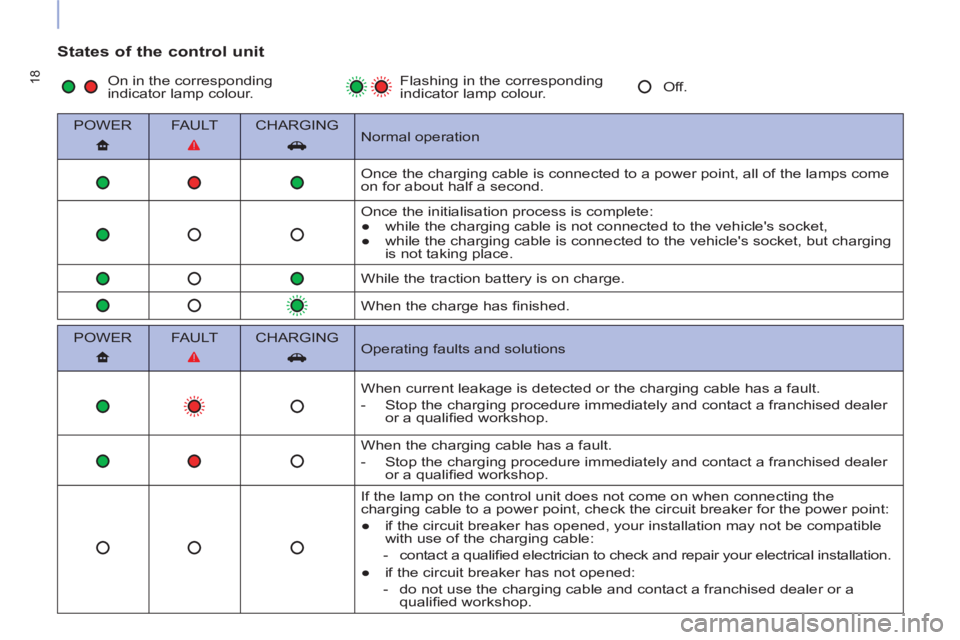
18
States of the control unit
POWER
FA U LT
CHARGING
Normal operation
Once the charging cable is connected to a power point, all of the lamps come
on for about half a second.
Once the initialisation process is complete:
●
while the charging cable is not connected to the vehicle's socket,
●
while the charging cable is connected to the vehicle's socket, but charging
is not taking place.
While the traction battery is on charge.
When the charge has fi nished.
POWER
FA U LT
CHARGING
Operating faults and solutions
When current leakage is detected or the charging cable has a fault.
- Stop the charging procedure immediately and contact a franchised dealer
or a qualifi ed workshop.
When the charging cable has a fault.
- Stop the charging procedure immediately and contact a franchised dealer
or a qualifi ed workshop.
If the lamp on the control unit does not come on when connecting the
charging cable to a power point, check the circuit breaker for the power point:
●
if the circuit breaker has opened, your installation may not be compatible
with use of the charging cable:
- contact a qualifi
ed electrician to check and repair your electrical installation.
●
if the circuit breaker has not opened:
- do not use the charging cable and contact a franchised dealer or a
qualifi ed workshop.
On in the corresponding
indicator lamp colour. Flashing in the corresponding
indicator lamp colour. Off.
Page 257 of 272

19
CHARGING THE TRACTION BATTERY
NORMAL CHARGING
PROCEDURE
Connection
- Check before charging that the
drive selector is in position P
and
the ignition is off, otherwise
charging is not possible,
- open the access fl ap at the right
hand front of the vehicle,
- take the charging cable (with its
control unit),
- fi rst connect the controller end
of the cable to a standard and
compatible power point. On
connection, the 3 controller
indicator lamps for POWER
,
FAULT
and CHARGING
come on
simultaneously for a moment, then
only the green POWER
indicator
lamp stays on,
- ensure that there is no foreign body
on the vehicle socket,
- remove the protective cover from
the charging cable,
- insert the charging plug into the
socket until it clicks in place,
without pressing the button,
- press the push button to open the
socket cover,